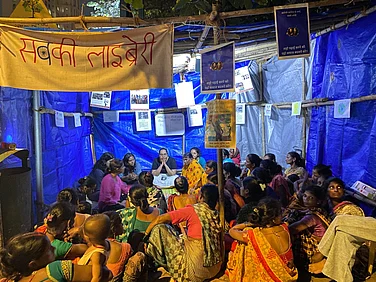Growing up in the late 1990s, younger millennials were the first generation to savour digital entertainment—video games et al—along with reading story books and magazines. Things have changed drastically since then. Though magazines like Anandamela or Kishore Bharati still enjoy considerable readership, the present generation of children lacks genuine interest in reading. The tendency to create only market-oriented, mediocre content has impeded experimentation in the post-globalisation Bengali culture.
“We had a rich tradition of children’s magazines in Bengal that published all types of content with the utmost care, especially science-based content,” says Parthajit Gangopadhyay, a long-time researcher of Bengali children’s literature, with more than fifty children’s books to his name. “But, most magazines of today look only for trash detective thrillers, bone-chilling ghost fiction, or stupid science-fiction stories that have no connection to reality. No coming-of-age stories, no science articles. In that sense, I would say, today’s magazines simply deviated from the ideology,” he adds.
This being the dominant picture, “there are a few exceptions like Alor Phulki, Dinginouko and Chirosobuj Lekha that publish writings that teach children basic human values,” points out Tapan Bandopadhyay, a two-time Sahitya Akademi awardee and the founder-secretary of Shishu Kishore Akademi (an institution dedicated to nurturing young talents).
But, given the current politically hostile situation in India and the social-media generated misinformation, are today’s leading children’s magazines able to do justice to their respective roles? “I don’t think so. Historically, politics has been kept aside when it comes to children’s literature. Moreover, there is danger in writing this kind of stuff nowadays, so none’s very willing to take that risk,” remarks Bandopadhyay.
Amazingly, just about hundred years ago, in British-ruled India, one Bengali magazine dared to take the bold step—it was Benu.
First published in April 1926 (the month of Baishakh of the Bengali calendar year 1333), Benu was the brainchild of Rebatimohan Burman, a devoted activist, publisher (one of the three founders of the National Book Agency) and Marxist theorist. The time was crucial. While Mahatma Gandhi’s non-violence earned nationwide admiration, armed resistance also gained significant ground. Communism entered the stage as well. Young, adolescent minds of Bengal were in search of something new, and with Sandesh having stopped in 1925, other popular contemporaries like Mouchak, Shishusathi or Khokakhuku were simply not enough to quench their thirst. At this juncture, came out Benu.
The magazine was probably named after a song by Rabindranath Tagore, published in the first issue. Benu means ‘flute’ in Bengali. Burman, a close associate of Mukti Sangha—a voluntary ‘Swadeshi’ organisation of Dacca that would transform into Bengal Volunteers Corps (BV) at the 1928 Calcutta Indian National Congress (INC) session—would soon be replaced by Bhupendrakishore Rakshit Roy as editor when a disagreement arose between him and Hemchandra Ghosh, the founder of Mukti Sangha, over the principal purpose of Benu. Davenham Press, run by Hemchandra Guha and Nirmalchandra Guha, took the printing responsibility.

Essentially a teenagers’ magazine, Benu published poems, rhymes, short stories, novels, novelettes, socio-political essays, science articles, travelogues, international news, obituaries, book reviews, and even song notations and fun-filled riddles for readers to solve. From selection of articles to editing, from illustrations to page layout, from printing to distribution—the editorial board never compromised on quality. Ghosh, who was a visionary, insisted that the magazine should act as a mouthpiece to spread revolutionary ideals among young readers, and editor Roy, an accomplished writer himself, took Benu to new heights.
Let us take the editorial columns, for instance. I found only a few copies available at Kolkata’s century-old Bangiyo Sahitya Parishat library and was simply fascinated by such a wide range of topics being covered in these columns—women empowerment, ongoing labour and student movements, mistreatment of political prisoners in British jails, consequences of communal violence, famine situation in Bengal, nationalist movements in China, throwing of bombs by Bhagat Singh and Batukeshwar Dutt at the Central Legislative Assembly, the general election of Britain, the Salt March, British atrocities at Chittagong and Hijli, Eastern Bengal Railway’s reluctance to disclose the exact number of deaths in the Belur train accident, and government bans imposed on other independent newspapers and magazines.
Another similar column was Bishwobarta (world news). Communication media had undergone rapid modernisation post-WW1, and Benu made full use of it. Some of the global issues covered in Bishwobarta include the 1927 Sacco and Vanzetti trial in the US, political and social reforms undertaken by Amir Amanullah of Afghanistan, enormous scientific, economic and industrial developments, happening in the Soviet Union, growing communist hostility among imperialist forces, US capitalism, the possibility of another great war piling up, and fielding of imprisoned Indian communist leader Shaukat Usmani as a communist candidate in the 1929 UK General Elections against the right-leaning Liberal John Simon. One would even find entertaining reports on film personalities and sports, coated with characteristic humour.

The primary target audience being teenagers, the editorial board paid special attention to the language of the news coverage. The direct and satiric tone helped readers know the grim reality, without the slightest provocation. Despite being the mouthpiece of an underground armed revolutionary organisation, Benu always honoured Gandhi’s non-violence and the INC. In the same issue, one can astonishingly find praise for Rasbehari Basu—‘the most dangerous man’ for the British—and support for Sardar Patel-led Bardoli Satyagraha organised against high government tax. They did criticise Congress leaders’ actions at times, most notably the Nehru Committee Report of 1928 and the Gandhi-Irwin Pact of 1930, but that too humbly, citing proper reasons. In the case of armed revolutionaries, too, the magazine saluted their lively spirits, but the judgment was always left to the reader.
Just like other magazines from this period, Benu put special emphasis on science articles. BV activist Mira Datta Gupta, an MA in Mathematics, contributed regularly to this column. The usage of simple language and everyday chores as references was aimed at helping young readers develop a rational mind. For instance, in an article on the galaxy, published in the Shraban issue of 1335 (July 1928), Gupta first referred to the conventional eclipse theories Hindus had believed over centuries, and then appealed to her readers: “You should not believe them because many others had to sacrifice their lives while fighting for this truth.”
Bimalchandra Ghosh, the founder-editor of Ananda Bazar Patrika’s children’s supplement Anandamela, once noted: “At that time, we had passed the age of reading ‘Khokakhuku’, our minds were stirred by the spirit of revolution—we could feel it wasn’t right to live in a fantasy world of detective and adventure stories, and were desperately looking for something to strengthen our nationalistic fervour. Benu provided that to us.”
Publication of martyrs’ (termed ‘terrorists’ or ‘dacoits’ in major newspapers) photographs and letters posed an enormous risk but earned Benu great popularity. The Ashwin issue of 1336 (October 1929) extensively covered the martyrdom of Jatindranath Das following an exemplary 63-day hunger strike at the Lahore Jail. The ‘Dinesh Gupta Issue’ that came out immediately after Dineshchandra Gupta’s hanging in July 1931, gained an unfathomable readership.
Contemporary influential litterateurs and political figures, Rabindranath Tagore (Nobel laureate, founder of Visva-Bharati), Prafullamoyee Debi (poet), Charuchandra Ghosh (novelist, short story writer), Kalidas Roy (poet), Kumudranjan Mallik (poet), Prabhabati Debi Saraswati (poet, short story writer, novelist), Saratchandra Chattopadhyay (the best-selling novelist at that time, who famously wrote in Benu without remuneration), Hasirashi Debi (poet), Sunirmal Basu (poet), Subhaschandra Bose (two-time INC president, the founder of Forward Bloc, leader of the INA), Dilipkumar Roy (singer, philosopher), Anilbaran Roy (poet, singer, philosopher), Leela Nag (one of the first two female students of University of Dacca, the founder of Dipali Sangha, a women’s underground organisation), Humayun Kabir (author, educationist, later, Education Minister of India), etc. contributed to Benu.

At its peak, note of Benu reached as far as Rangoon, Assam, Cuttack, Patna, Varanasi, New Delhi, Madras, Bombay, and Karachi.
The imperialist power made Bhupendrakishore face sedition trials and subsequent imprisonment for the first time in 1929, courtesy an editorial on labour exploitation and a short story by Sudhir Ghosh portraying the same. He was re-imprisoned the next year in the aftermath of the Lowman assassination at Dacca by BV member Benoykrishna Bose. Sunil Sengupta, the next editor, was also arrested soon. Prasannakumar Paul was the fourth and last serving editor. His arrest in early 1932 finally silenced Benu.
Though Rakhal Benu resurged in 1979 under the stewardship of BV veteran Satyen Chowdhury with repeat circulation of the “Dinesh Gupta Issue”, Benu lost its legacy in the ebb of time, probably due to its explicit political stance.
“From the Swadeshi period, revolutionary organisations like Anushilan Samity and Jugantar not only taught young boys the techniques of stick fighting and revolver shooting but also provided important books to read, as a part of their psychological development agenda. Benu can be seen as a fruit of this constructive practice. Unfortunately, this very aspect of armed struggle has always been overlooked,” said Mrinmoy Sengupta, a political activist.
“And, looking at the current political situation in India, this discussion has become more important than ever. Politics cannot be without culture, and culture cannot be without politics,” he added.
Soham Das is a Kolkata-based author, writer and researcher.























